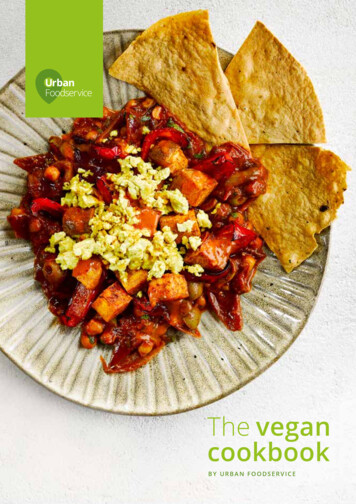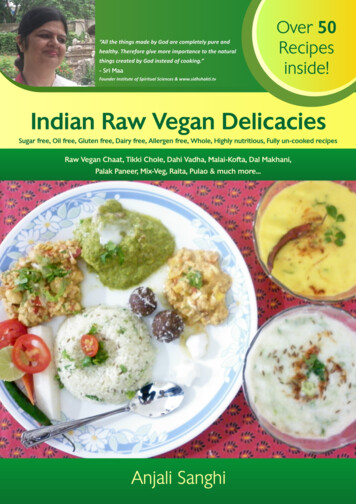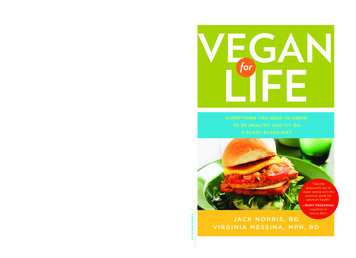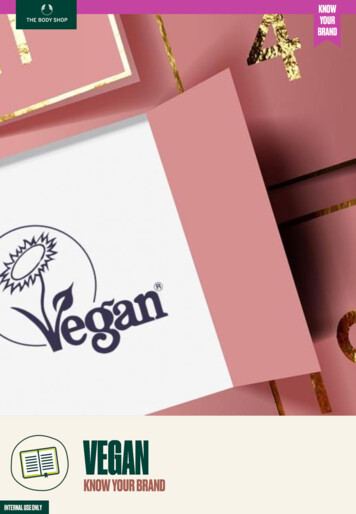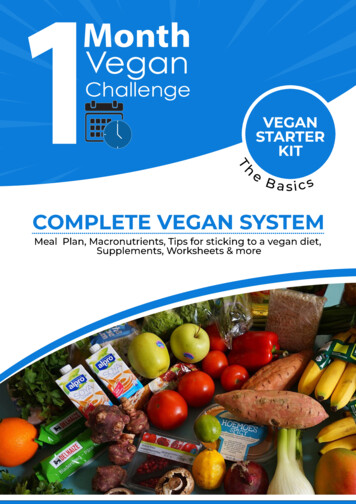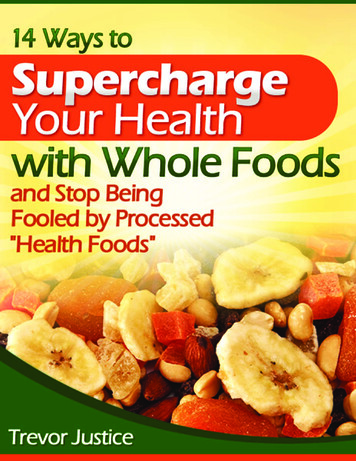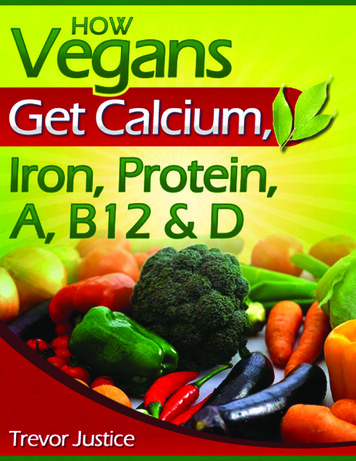
Transcription
The Vegetarian Health Institute 2010, All Right ReservedHow Vegans Get Protein, Calcium, Iron,Vitamins A, B12 & DIntroduction by Trevor Justice, Owner/DirectorI still remember that moment in 2009. I was at a vegan potluck with author Michael Klaper, M.D. At a certain point,someone asked about Lierre Keith.During her 20 years as a vegan, Lierre’s health got worse. After adding meat back to her diet, she felt rejuvenated andcondemned the vegan diet in her book, The Vegetarian Myth. My heart sinks when I hear stories like this.But there’s a reason vegans fail. Dr. Klaper explained it this way:Without the right game plan for meeting your nutritional needs, a plant based diet has real pitfalls. That’s why Lierre, andothers like her, develop health problems.Getting these nutrients on a plant based diet is entirely possible for most people.1 It’s what we teach. But you can’t goabout it haphazardly, like my friends and I did early on.We began attending vegetarian and raw food conferences 15 years ago. When the speakers told us that eating wholefoods was a cure-all, we took them at their word.When they touted the health benefits of veganism – with little mention of the risks – we became overconfident. Afterall, our risk of high blood pressure, cholesterol, and heart disease was dramatically lower. So surely we were invincible,right?With this false confidence, we took our health for granted. We rolled our eyes when omnivorous relatives worried aboutus. But eventually, some of us suffered health problems.Dr. Klaper impresses me because he doesn’t just harp on the benefits of the vegan diet. (There are many!) He alsoacknowledges the pitfalls. For example, Vitamins like B12 and D are harder to find in plant foods, and nutrients like ironand Vitamin A are harder to absorb. So you need a game plan.First, know which foods are high in these nutrients. Second, eat them in the right combinations to maximize absorption.And third, avoid foods, beverages, and drugs that keep your body from absorbing them.We created this booklet to accomplish two things:1) To show you which foods are high in these critical nutrients2) To give you a taste of what’s waiting for you in The Vegan Mastery ProgramIn 2009, I founded The Vegetarian Health Institute and teamed up with Dr. Klaper (and other experts) to create The VeganMastery Program. It’s a series of 50 lessons that teach you step-by-step how to thrive on a vegan diet.Each lesson contains a written component and a recorded Q&A call with a guest expert. Dr. Klaper is the expert Iinterview most often. He also authored all of our lessons on vitamins and minerals. Our program is also packed with lifesaving secrets from Registered Dietitians, and the authors of top vegan cookbooks and nutrition books.Click here to learn more about The Vegan Mastery Program. Or click here to get our free 10-day email course (if youhaven’t already signed up).1 For people who feel they require animal foods, it can be minimized to only “medicinal amounts” utilizing well-planned, “plantstrong” food choices.
CALCIUMThe plant foods highest in calcium are leafy greens likespinach, kale, and turnip greens. However, the food industryfortifies many staple foods with calcium – including orangejuice, soy milk, tofu, and breakfast cereals.1 This helps ensurethat we all get enough.Does this mean you don’t have to worry about calcium? Notnecessarily. As Dr. Klaper likes to say, “You’re not what youeat. You’re what you absorb.”So What Interferes With Calcium Absorption?Select Plant Sources Of CalciumCalcium in standard Calcium perportion (mg)100 grams (mg)Tofu, firm, made with calcium sulfate, raw½ cup434350Orange juice, calcium fortified6 ounces375201Soybeans, cooked1 cup261145Blackstrap Molasses1 Tbsp200183Tempeh1 cup184111Collard greens, boiled½ cup133140Tahini2 Tbsp128426Okra, cooked1 cup12377Spinach, boiled½ cup122136Instant breakfast drink, various, with water8 ounces105-250285Turnip greens, raw1 cup104190Ready to eat cereal, calcium fortified1 cup100-1000357-3571Turnip greens, boiled½ cup99137Kale, cooked1 cup9472Kale, raw1 cup90135Almonds¼ cup94264Almond butter2 Tbsp111347Soy milk, calcium fortified8 ounces340140Soy yogurt6 ounces300132Chinese cabbage, boiled½ cup7993Chinese cabbage, raw1 cup74105Sources: Report of the DGAC on the Dietary Guidelines for Americans, 2010, The Vegetarian Resource Group.FoodServing sizeHere are two factors that impede calcium absorption:1) P hytic Acid occurs naturally in the bran of whole grains,nuts, seeds, soy isolates, and the skins of legumes. It’sparticularly rich in isolated wheat bran.2 It binds tominerals like calcium, magnesium, iron, and zinc in yourintestines to form an insoluble complex, interfering withthe absorption of these minerals.32) O xalic Acid. Oxalic acid occurs naturally in many plantfoods. When oxalic acid and calcium are contained inthe same food, it binds to the calcium and forms lesssoluble salts known as oxalates. This interferes withabsorption. It has the same affect on iron, sodium,magnesium, and potassium, when contained in thesame food. The more oxalic acid, the more interference.2Some calcium rich foods high in oxalates are almonds,beets, cocoa, miso, mixed nuts, sesame seeds, spinach,and Swiss chard.4In lesson 3 of the Vegan Mastery Program -- “How ToAbsorb More Calcium From Your Meals” – you’ll discover: Which foods contain high, moderate, and lowamounts of oxalic acid How to release oxalic acid from your food, so youabsorb more calcium from your meals Six ways to release phytic acid during foodpreparation Which foods, condiments, and drugs inhibit calciumabsorption. The latest RDA for men, women, children, andpregnant and breastfeeding mothers Quick, delicious recipes high in both calcium and acomplimentary nutrient that supercharges calciumabsorption, so you absorb more calcium now and forthe rest of your life. For example: Lemony Lentil and Potato Chowder » Blanched Spinach with Toasted Sesame Dressing » Black-Eyed Peas & Spinach » Bean & Vegetable Soup »You’ll also get a downloadable 1-hour Q&A of MichaelKlaper, M.D, answering student questions.
IRONIron-rich plant foods include raisins, soybeans, lentils, kidneybeans, spinach, collards, pumpkin seeds, oat cereal, and quinoa.1Unlike the “heme” iron in flesh foods, only 10% – 20% of thenon-heme iron in plant foods gets absorbed by your body.5(Interestingly, neither eggs nor dairy contain iron.)The good news is this. There are three “magic” foodcombinations that dramatically enhance iron absorption fromvegan foods!Select Plant Sources Of IronIron in standardIron perportion (mg)100 grams (mg)Tempeh1 cup4.52.7Soybeans, mature, cooked½ cup4.45.1Fortified ready-to-eat cereals (various)¾ -1- ⅓ cup ( 1 ounce)4.2-18.18.2-62.0White beans, canned½ cup3.93.0Fortified instant cereals (various)1 packet3.8-17.22.5-6.7Blackstrap Molasses1 Tbsp3.62.4Tofu, raw, firm½ cup3.42.7Lentils, cooked½ cup3.33.3Potato, baked1 large3.21.1Quinoa, cooked1 cup2.81.6Tahini2 Tbsp2.79.0Chickpeas, cooked½ cup2.42.9Pumpkin and squash seed kernels, roasted1 ounce2.38.1Soybeans, green, cooked½ cup2.32.5Lima beans, cooked½ cup2.32.4Navy beans, cooked½ cup2.22.4Black-eyed peas, cooked½ cup2.22.5Cashews, dry roasted¼ cup2.16.0Swiss chard, cooked½ cup2.02.3Kidney beans, cooked½ cup2.02.2Sources: Report of the DGAC on the Dietary Guidelines for Americans, 2010, The Vegetarian Resource Group, andmanufacturers’ information.FoodServing sizeFor example, lacto fermented vegetables -- like sauerkraut-- enhance iron absorption when combined with iron richfoods.6 (The secret is the lactic acid.)Once you know all three iron-enhancing food groups, youcan combine any of them with iron-rich foods and instantlyabsorb more iron. Delicious recipes that employ the food combinationsreferenced above, so you absorb more iron now andfor the rest of your life. Here are a few of the mouthwatering recipes you’ll receive: Greens Sushi » Lemon-Rosemary Tempeh »In Lesson 7 of the Vegan Mastery Program -- “How toAbsorb More Iron From Your Meals” – you’ll discover: Spicy Thai Wraps » Which other food combinations make the iron inyour meals more absorbable Nomi’s Smoothie » Which food prep methods release iron-blockers fromwhole grains, nuts, seeds, and legumes. Orange-Cashew Crème » Which foods, beverages, and over-the-counter drugsimpede iron absorption. Kale and Potato Smash » The latest RDA for men, women, children, andpregnant and breastfeeding mothers Spinach Salad With Orange-Tahini Dressing » Spinach Puree » Greens Braised with Tomatoes and Thyme » Spinach with Warm Lentils »You’ll also get a downloadable 1-hour Q&A of MichaelKlaper, M.D, answering student questions.
PROTEINProtein is made up of 22 amino acids. However, you onlyneed nine of them from food. These are called the essentialamino acids (EAAs). Your body can create the others.7Most plant foods have all of the essential amino acids, butthe amounts of one or two are low. For example, whilegrains are low in lysine, legumes are low in methionine.7That’s why omnivores make such a “hub bub” about protein.Decades ago, the book Diet For A Small Planet led us tobelieve that beans and grains had to be combined in thesame meal. But the book’s author later retracted thatstatement!The protein in whole, unprocessed plant foods is not entirelydigestible.When you eat a well rounded diet of whole foods, you’realmost certain to get all nine EAAs in the course of a day.For example, you can eat beans with lunch and grains withdinner.That said, many vegans still find it comforting to includewhole proteins in their diets. Well here’s great news.Soybeans, soy “meats”, tofu, quinoa, and spinach are high inall 9 essential amino acids.7 How much protein do you need?The RDA recommends consuming 0.8 grams of protein forevery kilogram you weigh (or 0.36 grams of protein perpound you weigh).8If you primarily eat whole foods, however, we recommendincreasing that to 1 gram of protein per kilogram of bodyweight (or 0.45 grams of protein per pound that you weigh).Why?For example, the protein in whole soybeans has adigestibility score of 78%, whereas the protein from isolatedsoy protein, soy “meats”, tofu, and other soy foods is inthe 90-98% range. Likewise, refined wheat protein is moredigestible than the protein in whole wheat berries.9This is ironic, since we normally recommend whole foods,not their processed counterparts (which are stripped ofvitamins and minerals)! But the solution is simple: if you eatmostly whole foods, increase your protein intake to 1 gramper kilogram of body weight.We’ve just scratched the surface here. In lesson 14 of theVegan Mastery Program -- “Six Ways to Get Plenty ofProtein” – you’ll discover: The dangers of eating too much protein How to “transform” beans so they never cause gas,bloating, or indigestion.Select Plant Sources Of Protein(Italicized foods are high in all 9 essential amino acids.7)Protein in standardportion (mg)Soybeans, mature, cooked1 cup28.6Soybeans, immature, cooked (edamame)1 cup22.2Vegetarian burger crumbles1 cup22.2Couscous, dry1 cup22.1Tofu, raw, regular, prepared w/calcium sulfate1 cup20Barley, pearled, raw1 cup19.8White beans, canned1 cup19.0Lentils, cooked1 cup17.9Bulgur, dry1 cup17.2Split peas, cooked1 cup16.4Oat bran, raw1 cup16.3Pinto beans, cooked1 cup15.4Kidney beans cooked1 cup15.4Black beans, cooked1 cup15.2Quinoa, cooked1 cup8.1Pumpkin and squash seed kernels, roasted, with salt added 1 oz (142 seeds)9.4Peanuts, all types, dry-roasted, with salt1 oz (28 nuts)6.7Sunflower seed kernels, dry roasted, with salt added¼ cup6.2Pistachio nuts, dry roasted, with salt added1 oz (47 nuts)6.0Almonds1 oz (24 nuts)6.0Spinach, boiled1 cup5.4Spinach, raw1 cup0.9Source: USDA National Nutrient Database for Standard Reference, 2010, Release 23.FoodServing sizeProtein per100 grams .94.433.023.721.821.321.33.02.9
Which protein sources we discourage eating and why The six vegan food groups highest in protein The latest RDA for men, women, children, andpregnant and breastfeeding mothers Delicious high protein recipes like these, most ofwhich are soy-free: Tuscan White Bean Soup » Curried Lentils and Rice » Black Bean Quinoa Burgers » Hearty Cabbage Casserole »Heirloom Bean & Vegetable Soup »Faux Salmon (almond-based) »Sun Garden Burgers »Blanched Spinach with Toasted Sesame Dressing »Kale with Orange-Tahini Dressing »You’ll also get a downloadable 1-hour Q&A of VesantoMelina, R.D., answering student questions. Vesanto isa Registered Dietitian and author or co-author of sixnutrition books, including Becoming Vegetarian, BecomingVegan, and Becoming Raw.Note that athletes need more calories and protein than other people,especially when working out causes micro-tears in their muscles.That’s why we enlisted Robert Cheeke to write Lesson 19 of The VegetarianMastery Program, “Building Muscle”. Robert also answered studentquestions on the related Q&A call. Robert is a champion bodybuilder, andhe’s hailed as “one of the 15 most influential vegan athletes” by VegNewsMagazine.VITAMIN APlant foods don’t contain active Vitamin A. They contain its pre-cursor,beta-carotene. Beta carotene is 1/12 as potent as retinol, the activeVitamin A in animal foods.10Foods rich in beta carotene include broccoli, dark leafy greens likespinach, collards, and kale, carrots, yams, pumpkin, sweet potatoes,cantaloupe, apricots, papaya, mango, and peaches.1Select Plant Sources Of Beta Carotene (Pro Vitamin A)(Measured in Retinol activity equivalents. One RAE equals 12 mcg of beta-carotene)Vitamin A in standardportion (mcg RAE)Carrot juice1 cup2256Sweet potato, baked1 medium1096Pumpkin, cooked from fresh or canned½ cup306-953Carrots, cooked from fresh, frozen, or canned½ cup407-665Spinach, cooked from fresh, frozen, or canned½ cup472-573Kale, raw1 cup515Carrot, raw½ cup509Collards, cooked from fresh or frozen½ cup386-489Kale, cooked from fresh or frozen½ cup443-478Mixed vegetables, cooked from frozen or canned½ cup195-475Turnip greens, cooked from fresh or frozen½ cup274-441Turnip greens, raw1 cup318Fortified instant cereals (various)1 packet318-376Fortified ready-to-eat cereals (various)¾ - 1 ¼ cup ( 1 ounce) 177-307Mustard greens, raw294Dandelion greens, raw1 cup279Beet greens, cooked from fresh½ cup276Winter squash, cooked½ cup268Mustard greens, cooked from fresh½ cup221Romaine lettuce1 cup205Source: Report of the DGAC on the Dietary Guidelines for Americans, 2010FoodServing sizeVitamin A per 100grams (mcg 5214-583381-538579186-265442-991525508383261316436
Since beta carotene is the precursor to Vitamin A, it mightseem like you could get enough Vitamin A just by eatingbeta carotene foods. But the rate of conversion to VitaminA isn’t guaranteed. Although your body is designed to turnbeta carotene into Vitamin A, two things can affect thisconversion process:1) The beta carotene in vegetables is hard to absorb,especially those with tough cell walls.112) Few people eat beta carotene together with thenutrients that supercharge Vitamin A production(when combined with beta carotene foods).Here’s the good news. There are three food preptechniques that break down the cell walls in vegetables,making beta carotene easier to absorb. Cooking is one ofthem.11 The other two will be a Godsend if you eat lots ofraw vegetables.In lesson 13 of the Vegan Mastery Program --“How toConvert More Beta Carotene Into Active Vitamin A” –you’ll discover: Which three food prep techniques break open thecell walls in vegetables, making their beta caroteneeasier to absorb Which two nutrients supercharge the conversion ofbeta-carotene into Vitamin A, when you eat them atthe same time The latest RDA for men, women, children, andpregnant and breastfeeding mothers Delicious recipes that employ the food combinationsreferenced above, so you convert far more betacarotene into Vitamin A, now and for the rest of yourlife. For example: Basil-Red Pepper Sauce » Zucchini Chedda Soup » Curried Cashew Crème Sauce » Sesame Ginger Kale » Sweet Potato and Cashew Korma with Rice »You’ll also get a downloadable 1-hour Q&A of MichaelKlaper, M.D, answering student questions.Recipes in cookbooks are only designed to taste great. Butwhat about nutrients – like iron and Vitamin A -- that areharder to absorb from plant foods? Our recipes aren’t justdelicious. They follow the life-saving food combinations weteach. So you absorb far more vitamins and minerals.VITAMIN B12The medical literature brims with case studies of vegans -- infants, children, adults, andthe elderly -- who’ve incurred bodily damage from B12 deficiency.12The most reliable plant sources of B12 are supplements and B12-fortified foods. Theseinclude cereals, non-dairy milks, Red Star nutritional yeast, and “meats” made fromwheat gluten or soybeans).13The supplement we recommend is called “Gentle Care”. It contains 30 mcg of VitaminB12, which is 500% of the US RDA. It’s available at www.veganmultivitamin.comSelect Plant Sources Of Vitamin B12Vitamin B12 in standard Vitamin B12 per 100portion (mcg)grams (mcg)Gentle Care Formula2 capsules30n/aRed Star nutritional yeast1 Tbsp5.248.8Vegetarian burger crumbles, frozen1 cup4.5-9.138.3-12.9Fortified breakfast cereals (various)¾ - 1 ⅓ cup ( 1 ounce)1.5-20.72.7-6.0Fortified soy milk, fortified1 cup3.01.1Fortified rice milk, unsweetened1 cup1.510.63Sources: Report of the DGAC on the Dietary Guidelines for Americans, 2010, manufacturers’ information.FoodStandard portion sizeIn Lesson 9 of the Vegan Mastery Program -- “The TruthAbout Vitamin B12” -- you’ll discover: When nutritional yeast has less B12 than it claims to How much B12 is in fermented soy products,amesake rice, umeboshi prunes, and the soil onunwashed veggies Which foods are purported to be good B12 sources,but actually block the absorption of active B12 causing B12 deficiency. How to know if you’re deficient in B12 The latest RDA for men, women, children, andpregnant and breastfeeding mothers A mouth watering recipe for a Nutritional YeastGravy.You’ll also get a downloadable 1-hour Q&A of MichaelKlaper, M.D, answering student questions.
“I’ve been a vegan/macrobiotic cookbook author, food coach and speaker for 37years. Yet I continue refining my understanding of nutrition, thanks to the broadrange of experts Trevor brings to the Q&A calls. My interest in sprouting and juicinghas been renewed, and the insights shared on bone health and Vitamins D and B12have been revelatory.”– Meredith McCarty, Mill Valley, CAVITAMIN DNot long ago, we believed most people could get adequatevitamin D from sunlight. On this basis, the USDA recommended the following daily intake for both men and women:Birth to 50 years:5 mcg (200 IU)51-70 years: 10 mcg (400 IU)71 years: 15 mcg (600 IU)In recent years, however, we’ve realized the limited powerof the sun to produce adequate vitamin D levels. While the“official” dosage recommendations have yet to be revisedupward by the U.S. government, here’s what we arerecommending now:For infants/children: 400 IU daily.14For men and women: 1000 – 2000 IU daily.15In their natural form, only two plant foods contain vitaminD: algae and mushrooms. (But the amounts are small.)The problem isn’t limited to vegans. Even many omnivoresare at risk for Vitamin D deficiency. This a huge concernbecause your body needs vitamin D to absorb calcium, andbuild and maintain strong bones.Fortification To The RescueFor these reasons, it’s become common practice to“fortify” orange juice, breakfast cereals, and other staplefoods with vitamin D3.For omnivores, this is no problem. But if you’re a vegan,you may be alarmed to know that Vitamin D3 can comefrom sheep wool lanolin, pig skin, or cow skin.16 And here’sthe clincher Select Plant Sources Of Vitamin DThere’s no law requiring food manufacturers to indicatethe source of the D3 in their foods. There couldn’tbe. That’s because after D3 is extracted, purified, andcrystallized, it’s impossible to determine the originalsource.16 But there are two pieces of good news:1) Most non-dairy milks are fortified with plant-basedVitamin D2. 1 cup of fortified soy / rice / almond /oat milk typically contains 100 IU.12) When Portabello mushrooms and white“button” mushrooms are briefly exposedto intense ultraviolet light, their naturallyoccurring ergosterol is activated to vitamin D2(ergocalciferol) in quite significant amounts.17 3ounces of UV-exposed mushrooms contain 1520IU!18 You can find these at most health food stores.So how can adults get 1000 IU daily? You can make UVexposed mushrooms a staple in your daily diet. Or you cantake a supplement like “Gentle Care Formula”. It contains1,000 IU of Vitamin D2 and 30 mcg of B12. It’s available atwww.veganmultivitamin.comStandard portionsizeGentle Care Formula2 capsulesUV-exposed Portabello mushrooms1 cupSoymilk, fortified with plant based D21 cupFortified ready-to-eat cereals, typically fortified with¾ - 1 ¼ cupanimal based D3( 1 ounce)Rice milk, fortified with plant based D21 cupOrange juice, fortified with animal based D3½ cupShiitake mushrooms (not UV exposed)½ cupSource: Report of the DGAC on the Dietary Guidelines for Americans, 2010.FoodVitamin D in standardportion (mcg)259.62.70.9-2.52.41.70.6Vitamin D per 100grams (mcg)n/a11.21.12.9-8.31.01.40.8
In lesson 11 of the Vegan Mastery Program -- “The TruthAbout Vitamin D” – you’ll discover: Which other foods are fortified with plant-basedVitamin D The latest RDA for men, women, children, andpregnant and breastfeeding mothers Delicious ways to prepare UV-exposed mushroomsincluding: How Vitamin D partners with calcium to keep yourbones strong Why you probably get less Vitamin D from the sunthan once believed How to know if you’re deficient in Vitamin DHungarian Mushroom SoupMarinated MushroomsPortobello Mushroom BurgersYou’ll also get a downloadable 1-hour Q&A of MichaelKlaper, M.D, answering student questions.OMEGA 3sFlax seeds, hemp seeds, walnuts, and their respective oilsare the best sources of alpha-linolenic acid (ALA), a shortchain Omega-3 fatty acid.But your body also needs two long chain Omega-3fatty acids: EPA (eicosapentaenoic acid) and DHA(docosahexaenoic acid). So how do you get those?Unfortunately, EPA and DHA are almost non-existent inplant foods. No wonder studies have found that bloodlevels of EPA and DHA are lower in vegans than in meateaters.19 20There’s one exception: algae. In fact, if you want to takeDHA in supplement form, Dr. Joel Fuhrman makes the casethat algae based DHA is superior to fish oil. Why?Most fatty fish contain potentially harmful pollutants, suchas dioxin and mercury. People also experience burping andindigestion from these oils because of the fishy taste andfoul odor.The algae-based DHA we recommend is here:http://www.bestvegandha.comBut what if you don’t take DHA supplements?Can your body can convert ALA to EPA and DHA?It’s possible. However — and this is a BIG“however” — the rate of conversion is low inwomen and very low in men.21 Why?Select Plant Sources Of Alpha Linolenic AcidStandard portionALA in standardALAsizeportion (mg)per 100 grams (g)Walnuts¼ cup2,270-2,7009.1-10.8Flaxseed oil1 tsp2,40053.3Peanut butter containing flaxseed oil2 Tbsp1,0001.0Kashi Go Lean Crunch!, Honey Almond Flax1 cup1220.2Whole Flaxseeds1 tsp90026.5Soy nuts¼ cup6201.4Chia seeds1 tsp80017.6Flaxseed, ground1 tsp57022.8Soybeans, cooked½ cup5140.6Walnut oil1 tsp47010.4Canola oil1 tsp4008.9Unshelled hemp seeds1 tsp33310Broccoli, raw1 cup3000.3Soybean oil1 tsp3006.7Pecans¼ cup2400.9Tofu½ cup2280.2Soymilk1 cup2100.1Collards, raw1 cup2000.6Broccoli, cooked1 cup1900.1Cabbage, cooked1 cup1650.1Sources: R eport of the DGAC on the Dietary Guidelines for Americans, 2010, The Vegetarian Resource Group,manufacturers’ information.Food
The modern American diet is loaded with oils that are highin Omega 6 fatty acids. The latest RDA for men, women, children, andSure, you need Omega 6’s in your diet. But the optimalratio of Omega 6 to Omega 3 is about 1:1 (an equalamount of both).22 Many oils have terrible ratios. Forexample, corn oil has a 57:1 ratio and safflower oil has a76:1 ratio (in favor of Omega 6)!23 A chart showing the Omega 6:3 ratios of 18If you eat processed foods, packaged foods, or restaurantfoods made with the wrong oils, this Omega 6:3 imbalancecan interfere with DHA and EPA production in your body even if you eat plenty of flax seeds and walnuts.24In lesson 5 of the Vegan Mastery Program -- “How toConvert ALA (the Plant-Based Omega 3) into EPA andDHA” – you’ll discover: Which foods and oils interfere with your body’sability to make DHA and EPA. How to maximize DHA and EPA production.pregnant and breastfeeding mothersdifferent oils. A delicious recipe for a Lemon-Flax OilVinaigrette that you can use in place ofcommercial salad dressings and skyrocket yourdaily intake of ALAs.You’ll also get a downloadable 1-hour Q&A of MichaelKlaper, M.D, answering student questions.Did you find this booklet helpful? If so, why stophere? We’ve only scratched the surface. Click hereto learn more about The Vegan Mastery Program. Orclick here to get our free 10-day email course (if youhaven’t already signed up).
(Endnotes)1 USDA Report of the Dietary Guidelines Advisory Committee(DGAC) On The Dietary Guidelines for Americans, 2010, PartD, Section 2: Nutrient Adequacy15 B ischoff-Ferrari, HA et alFracatue prevention with vitamin Dsupplementation JAMA 200(18)5;293.2257-2264 Fuhrman, JHealthy Times newsletter, No.39; Winter 20092 The Encyclopedia of Nutrition and Good Health, 2nd Edition,Robert Ronzio, PhD, 2005, Checkmark Books, p513.16 P rofessor Anthony W. Norman, December 2000,“How is vitamin D produced commercially for foodsupplementation?”, Department of Biochemistry &Biomedical Sciences, University of California, Riverside CA925213 Robert Ronzio, PhD, The Encyclopedia of Nutrition and GoodHealth, 2nd Edition. Checkmark Books, 2005, p513.4 Andrew Weil, M.D., DrWeil.com, “Avoid Vegetables WithOxalic Acid?”, bles-with-Oxalic-Acid.html , January 20085 The Vegetarian Mastery Program, Lesson 7.1, “How To AbsorbMore Iron From Your Meals”. Michael Klaper, M.D.6 Int J Vitam Nutr Res. 2004 Nov;74(6):403-19. Enhancers ofiron absorption: ascorbic acid and other organic acids.7 Reed Mangels, Ph.D, RD, Protein in the Vegan Diet, http://www.vrg.org/nutrition/protein.htm8 Food and Nutrition Board, Institute of Medicine. DietaryReference Intakes for Energy, Carbohydrate, Fiber, Fat, FattyAcids, Cholesterol, Protein, and Amino Acids. Washington,DC: National Academy Press, 2002.9 Becoming Vegan p4410 Michael Klaper, M.D. The Vegan / Vegetarian MasteryProgram, Lesson 13.1: How To Maximize The Conversion ofBeta Carotene into Active Vitamin A.11 Forum Nutr. 2009;61:55-63. Epub 2009 Apr 7. Absorptionand function of dietary carotenoids. Nagao A. National FoodResearch Institute, National Agriculture and Food ResearchOrganization, Tsukuba, Japan. nagao@affrc.go.jp12 Ashkenazi S, Weitz R, Varsano I, Mimouni M. Vitamin B12deficiency due to a strictly vegetarian diet in adolescence.Clinical Pediatrics 1987;26(Dec):662-663. Brants HA, LowikMR, Westenbrink S, Hulshof KF, Kistemaker C. Adequacy ofa vegetarian diet at old age (Dutch Nutrition SurveillanceSystem). J Am Coll Nutr 1990 Aug;9(4):292-302. Dwyer JT,Dietz WH Jr, Andrews EM, Suskind RM. Nutritional status ofvegetarian children. Am J Clin Nutr 1982 Feb;35(2):204-16.13 Michael Klaper, M.D. The Vegan / Vegetarian MasteryProgram, Lesson 9.1: The Truth About Vitamin B-12.December 200914 Am J Clin Nutr. 2008 Aug;88(2):529S-533S.25-Hydroxyvitamin D: functional outcomes in infants andyoung children.Greer FR.Department of Pediatrics, University of Wisconsin,Madison, WI, USA. frgreer@pediatrics.wisc.edu17 J Agric Food Chem. 2009 Apr 22;57(8):3351-5.Vitamin D2 formation and bioavailability from Agaricusbisporus button mushrooms treated with ultravioletirradiation.Koyyalamudi SR, Jeong SC, Song CH, Cho KY, Pang G.Centre for Plant and Food Science, College of Health andScience, University of Western Sydney, Penrith South DC,NSW 1797, Australia.J Agric Food Chem. 2009 Apr 22;57(8):3351-5.Western Regional Research Center, Agricultural ResearchService, United States Department of Agriculture, 800Buchanan Street, Albany, California 94710, USABr J Nutr. 2005 Jun;93(6):951-5.Bioavailability of vitamin D2 from irradiated mushrooms: anin vivo study.Jasinghe VJ, Perera CO, Barlow PJ.Department of Chemistry, Food Science & TechnologyProgramme, National University of Sin, 3 Science Drive 3,Singapore 11754318 J Agric Food Chem. 2008 Jun 25;56(12):4541-4. Epub 2008Jun 4.Vitamin D2 formation from post-harvest UV-B treatment ofmushrooms (Agaricus bisporus) and retention during storage.Roberts JS, Teichert A, McHugh TH.19 D avis BC, Kris-Etherton PM. 2003. Achieving optimal essentialfatty acid status in vegetarians: current knowledge andpractical implications. Am J Clin Nutr 78(suppl):640S-46S.20 R osell MS, Lloyd-Wright Z, Appleby PN, et al. 2005. Longchainn-3 polyunsaturated fatty acids in plasma in British meateating, vegetarian, and vegan men. Am J Clin Nutr 82:327-34.21 3 Williams CM, Burdge G. 2006. Long-chain n-3 PUFA: plant v.marine sources. Proc Nutr Soc 65:42-50.22 D r. Andrew Weil, MD. February 2007, “Balancing Omega-3and Omega-6” www.drweil.com23 M anitoba Harvest Hemp Oils & Foods, http://www.manitobaharvest.com/24 Composition of Foods. USDA Nutrient Data Base for StandardReference, Release 18, 2005, and manufacturers’ information.
2) To give you a taste of what’s waiting for you in The Vegan Mastery Program In 2009, I founded The Vegetarian Health Institute and teamed up with Dr. Klaper (and other experts) to create The Vegan . Mastery Prog
